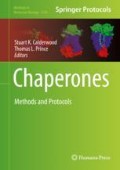Abstract
The formation of aggregates by polyglutamine-containing (polyQ) proteins in neurons is a key to the pathogenesis of several progressive neurodegenerative diseases such as Huntington’s disease (HD) spinocerebellar ataxias (SCAs), and spinal and bulbar muscular atrophy (SBMA). In order to study whether the members of the heat shock protein (HSP) families, by virtue of their molecular chaperone activity, can inhibit the formation of polyQ aggregates, we developed a cell culture model expressing the GFP tagged fragment of exon1 of the huntingtin gene with an expanded polyQ chain and tetracycline inducible chaperones. Expression of mutated Huntington’s protein leads to the formation of 2% SDS insoluble high molecular weight polyQ aggregates that are retarded on a cellulose acetate membrane in the so-called filter trap assay (FTA). This chapter explains in detail the protocols of the FTA and how it can be a useful tool to study the effect of HSPs or their functional mutants on aggregation of polyglutamine proteins. Moreover, the assay is useful to investigate how externally added polyQ peptides can act as nucleation seeds for internally expressed polyQ proteins.
Access this chapter
Tax calculation will be finalised at checkout
Purchases are for personal use only
References
Chiti F, Dobson CM (2006) Protein misfolding, functional amyloid, and human disease. Annu Rev Biochem 75:333–366
Zoghbi HY, Orr HT (2000) Glutamine repeats and neurodegeneration. Annu Rev Neurosci 23:217–247
Schilling G, Klevytska A, Tebbenkamp ATN et al (2007) Characterization of huntingtin pathologic fragments in human Huntington disease, transgenic mice, and cell models. J Neuropathol Exp Neurol 66:313–320
Gusella JF, MacDonald ME (2000) Molecular genetics: unmasking polyglutamine triggers in neurodegenerative disease. Nat Rev Neurosci 1:109–115
Neef DW, Turski ML, Thiele DJ (2010) Modulation of heat shock transcription factor 1 as a therapeutic target for small molecule intervention in neurodegenerative disease. PLoS Biol 8:e1000291
Warrick JM, Chan HY, Gray-Board GL et al (1999) Suppression of polyglutamine-mediated neurodegeneration in Drosophila by the molecular chaperone HSP70. Nat Genet 23:425–428
Kampinga HH, Bergink S (2016) Heat shock proteins as potential targets for protective strategies in neurodegeneration. Lancet Neurol 15:748–759
Labbadia J, Morimoto RI (2013) Huntington’s disease: underlying molecular mechanisms and emerging concepts. Trends Biochem Sci 38:378–385
Kakkar V, Meister-Broekema M, Minoia M et al (2014) Barcoding heat shock proteins to human diseases: looking beyond the heat shock response. Dis Model Mech 7:421–434
Kakkar V, Prins L, Kampinga H (2012) DNAJ proteins and protein aggregation diseases. Curr Top Med Chem 12:1873–4294. Review
Vos MJ, Zijlstra MP, Kanon B et al (2010) HSPB7 is the most potent polyQ aggregation suppressor within the HSPB family of molecular chaperones. Hum Mol Genet 19:4677–4693
Hageman J, Rujano MA, van Waarde MAWH et al (2010) A DNAJB chaperone subfamily with HDAC-dependent activities suppresses toxic protein aggregation. Mol Cell 37:355–369
Scherzinger E, Lurz R, Turmaine M et al (1997) Huntingtin encoded polyglutamine expansions form amyloid-like protein aggregates in vitro and in vivo. Cell 90:549–558
Bailey CK, Andriola IFM, Kampinga HH et al (2002) Molecular chaperones enhance the degradation of expanded polyglutamine repeat androgen receptor in a cellular model of spinal and bulbar muscular atrophy. Hum Mol Genet 11:515–523
Carra S, Sivilotti M, Zobel ATC et al (2005) HspB8, a small heat shock protein mutated in human neuromuscular disorders, has in vivo chaperone activity in cultured cells. Hum Mol Genet 14:1659–1669
Scherzinger E, Sittler A, Schweiger K et al (1999) Self-assembly of polyglutamine-containing huntingtin fragments into amyloid-like fibrils: implications for Huntington’s disease pathology. Proc Natl Acad Sci U S A 96:4604–4609
Hageman J, Kampinga HH (2009) Computational analysis of the human HSPH/HSPA/DNAJ family and cloning of a human HSPH/HSPA/DNAJ expression library. Cell Stress Chaperones 14:1–21
Rujano MA, Kampinga HH, Salomons FA (2007) Modulation of polyglutamine inclusion formation by the Hsp70 chaperone machine. Exp Cell Res 313:3568–3578
Brundin P, Melki R, Kopito R (2010) Prion-like transmission of protein aggregates in neurodegenerative diseases. Nat Rev Mol Cell Biol 11:301–307
Ren P-H, Lauckner JE, Kachirskaia I et al (2009) Cytoplasmic penetration and persistent infection of mammalian cells by polyglutamine aggregates. Nat Cell Biol 11:219–225
Kakkar V, Månsson C, de Mattos EP et al (2016) The S/T-rich motif in the DNAJB6 chaperone delays polyglutamine aggregation and the onset of disease in a mouse model. Mol Cell 62:272–283
Fujikake N, Nagai Y, Popiel HA et al (2008) Heat shock transcription factor 1-activating compounds suppress polyglutamine-induced neurodegeneration through induction of multiple molecular chaperones. J Biol Chem 283:26188–26197
Vos MJ, Carra S, Kanon B et al (2016) Specific protein homeostatic functions of small heat-shock proteins increase lifespan. Aging Cell 15:217–226
Tebbenkamp ATN, Borchelt DR (2009) Neuroproteomics. Protein Aggregate Characterization in Models of Neurodegenerative Disease 566:85–91
Peelaerts W, Bousset L, Van der Perren A et al (2015) α-Synuclein strains cause distinct synucleinopathies after local and systemic administration. Nature 522:340–344
Bousset L, Brundin P, Böckmann A et al (2016) An efficient procedure for removal and inactivation of alpha-synuclein assemblies from laboratory materials. J Parkinsons Dis 6:143–151
Acknowledgments
This work was supported by a grant from Senter Novem (IOP-IGE07004) and a Stimulation Grant from the Nederlandse Hersenstichting (project 15F07(2)-58) awarded to H.H.K. The authors wish to thank Dr. M.A. Rujano and Dr. J. Hageman for their contribution to the introduction of the Filter Trap Assay in our lab. The corrections and suggestions after careful reading of the manuscript by E. Preusser de Mattos are very much appreciated.
Author information
Authors and Affiliations
Corresponding author
Editor information
Editors and Affiliations
Rights and permissions
Copyright information
© 2018 Springer Science+Business Media, LLC
About this protocol
Cite this protocol
van Waarde-Verhagen, M.A.W.H., Kampinga, H.H. (2018). Measurement of Chaperone-Mediated Effects on Polyglutamine Protein Aggregation by the Filter Trap Assay. In: Calderwood, S., Prince, T. (eds) Chaperones. Methods in Molecular Biology, vol 1709. Humana Press, New York, NY. https://doi.org/10.1007/978-1-4939-7477-1_5
Download citation
DOI: https://doi.org/10.1007/978-1-4939-7477-1_5
Published:
Publisher Name: Humana Press, New York, NY
Print ISBN: 978-1-4939-7476-4
Online ISBN: 978-1-4939-7477-1
eBook Packages: Springer Protocols

